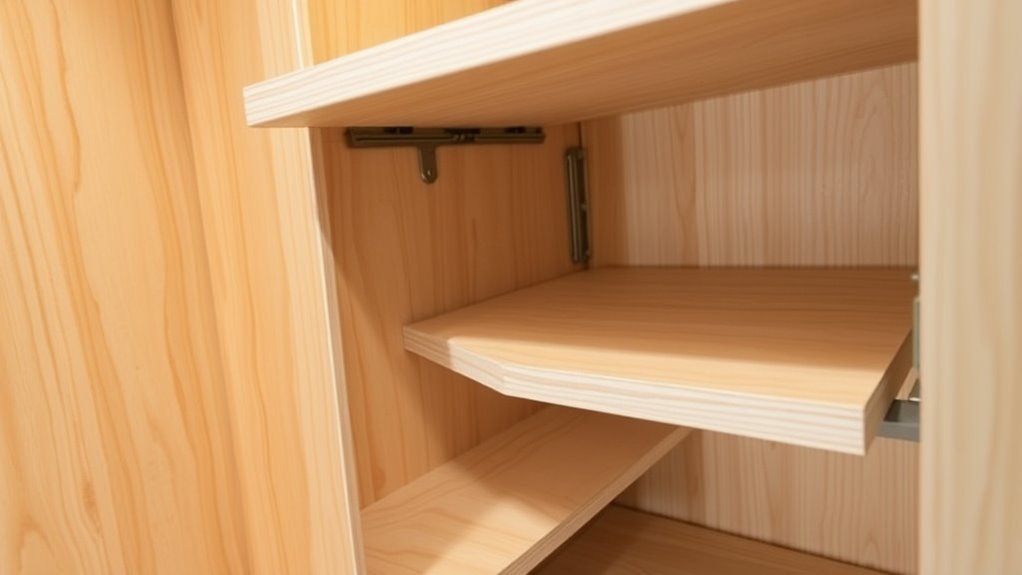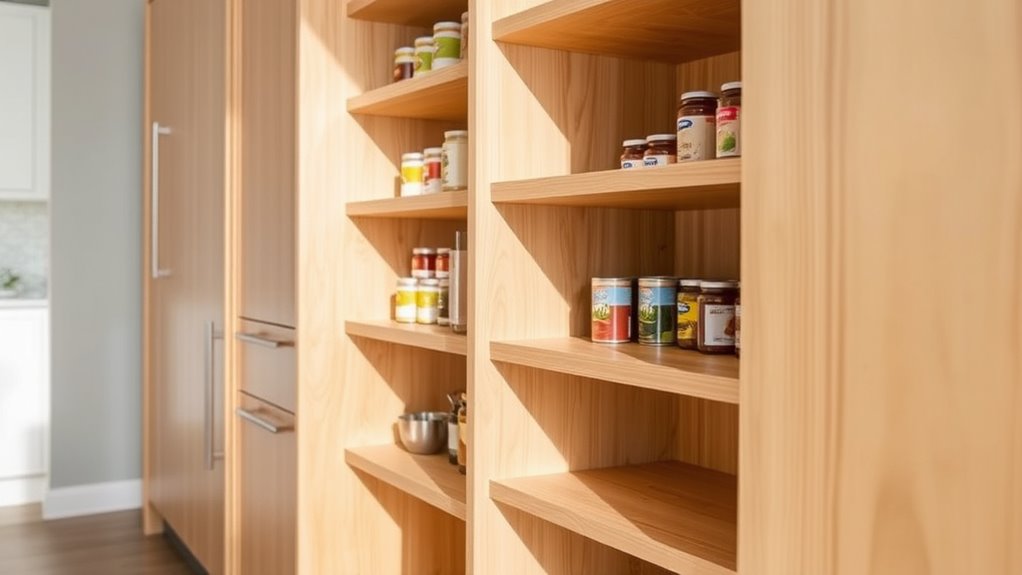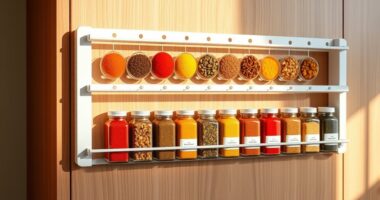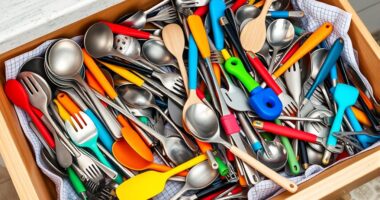To guarantee your plywood pantry pullouts are safe and durable, choose hardware with load ratings at least 20% above your heaviest items. Use heavy-duty full-extension slides, preferably ball-bearing for strength and longevity, and verify they support the weight you plan to load. Proper installation, including secure mounting and alignment, is key to preventing failures. Staying aware of load capacities and best practices will help you build dependable pullouts—keep going to discover more tips to optimize your project.
Key Takeaways
- Select hardware with load ratings exceeding the heaviest items stored to ensure safety and durability.
- Use full-extension, ball-bearing slides for heavier pantry pullouts to support weight and provide full access.
- Securely mount slides to plywood pullouts and cabinet walls, following manufacturer instructions for proper alignment.
- Consider corrosion-resistant, wear-resistant materials for hardware to enhance longevity and performance.
- Distribute weight evenly across pullouts and incorporate safety buffers in load ratings for added stability.

Ever wondered how to maximize your pantry space while keeping everything easily accessible? Building your own plywood pantry pullouts can be a game-changer, but the key lies in choosing the right hardware and understanding load capacity. When selecting hardware, you need to focus on components that can handle the weight of your stored items while also providing smooth operation. Heavy-duty drawer slides or pullout mechanisms are essential, especially if you plan to store heavier items like canned goods, small appliances, or bulk supplies. Opt for slides with high load ratings, typically indicated on the packaging, to ensure they can support your pantry’s demands. This way, you prevent sagging or failure over time, which could lead to frustration or even safety issues.
Your hardware selection should also match the size and weight distribution of your pullouts. For lighter items, standard slides might suffice, but for heavier loads, investing in full-extension, ball-bearing slides with higher load capacities is wise. These slides allow you to access the back of the pantry easily and support greater weight without compromising stability. Remember, load capacity isn’t just about the total weight but also how that weight is distributed across the hardware. Properly aligning your pullouts and evenly loading them will help maximize their lifespan and performance.
Choose full-extension, ball-bearing slides for heavier loads to ensure stability and easy access.
Another vital aspect of hardware selection is durability. Choose materials that resist wear and tear, especially if your pantry sees frequent use. Metal slides with corrosion-resistant coatings are ideal for longevity and smooth operation. Additionally, consider soft-close features if you want a quieter, more refined experience. This kind of hardware not only improves functionality but also adds a touch of sophistication to your DIY project.
Before starting your build, measure your pantry space carefully and select hardware rated for slightly more than your expected maximum load. This provides a buffer for unexpected weight or future additions. Proper installation is equally important: ensure your slides are mounted securely to both the plywood pullouts and the cabinet walls, following manufacturer instructions closely. Misalignment or loose mounting can drastically reduce load capacity and cause premature failure.
Frequently Asked Questions
How Do I Prevent Plywood Warping Over Time?
To prevent plywood warping over time, you should guarantee proper plywood sealing and maintain ideal storage conditions. Seal both sides of the plywood with a waterproof finish to protect against moisture. Store your plywood in a cool, dry place away from direct sunlight and humidity. Proper sealing and controlled storage conditions help stabilize the wood, reducing the risk of warping and ensuring your pantry pullouts stay sturdy and functional over time.
What Tools Are Essential for Building Pantry Pullouts?
You’ll need a drill with drive screws to securely assemble your pantry pullouts. A measuring tape or square is essential to measure accurately, guaranteeing everything fits perfectly. A saw helps cut plywood to size, while clamps hold pieces steady during assembly. A level ensures your pullouts are straight, and a pencil marks measurements. Together, these tools make building sturdy, precise pullouts easier and more efficient.
How Can I Customize Pullout Sizes for Different Items?
You can customize pullout sizes by using adjustable dividers and setting custom shelf heights. Measure the items you want to store, then adjust the dividers to create compartments that fit perfectly. For taller or shorter items, modify the shelf heights accordingly. This flexibility guarantees your pantry remains organized and tailored to your needs, making it easy to access everything efficiently. Always double-check measurements before cutting or assembling.
What’s the Best Way to Secure Heavy Items in Pullouts?
To secure heavy items in your pullouts, focus on proper weight distribution and sturdy hardware. Use anti-tip brackets to prevent tipping or shifting, especially for taller or heavier loads. Also, consider installing reinforced sides or bottom panels to support the weight. Make sure the hardware you choose is rated for the load, and evenly distribute weight across the pullout to minimize stress on any one point, ensuring safety and durability.
How Do I Maintain Smooth Operation of the Pullout Hardware?
Your pullout hardware is the backbone of smooth operation—don’t let it turn into a clunky obstacle! To keep it running flawlessly, regularly clean slide rollers to prevent dust buildup. Make alignment adjustments as needed to ensure the pullout glides effortlessly. Applying a light lubricant can also work wonders. With consistent care, your pullouts will operate as smoothly as a well-oiled machine, lasting for years to come.
Conclusion
Think of your plywood pantry pullouts as the veins of your kitchen—strong, essential, and built to support your daily needs. When I first installed mine, I was amazed how a simple DIY project transformed chaos into order, much like a well-organized highway system. With the right load ratings and hardware, your pullouts will handle everything from canned goods to heavy pots. Trust your skills, and your pantry will run smoother than ever.









